Olympic Arms "T48 2000" FAL Receiver and Rifle Review
(updated 11-05-01)
Background.
Customer sent to Arizona Response Systems in October of 2001 an Olympic Arms T48 2000 "FAL" for evaluation. He purchased it as a 100% metric rifle from Olympic Arms, but after his examination, he believed it to have inch pattern features. He also noticed some things that "didn't look right" but admitted he was unfamiliar with the FAL family of rifles. Purpose of sending it was for an explanation of "what do I have" and "Is it any good?"
I review products for end users and for manufacturers. While not claiming any fancy titles, I do have some experience with the FAL family of rifles and am reasonably knowledgeable on the subject. This allows me to build rifles for resale, build customer rifles, and to torture test and troubleshoot prototype products for several manufacturers to ensure a high-quality production model. I pride myself in objectivity and meticulous documentation. It is extremely difficult to write an objective evaluation, however, when the first impression I had when opening the box was deep disappointment. So if you are short on time, I will print the summary first.
Summary
The Olympic Arms T48 2000 is a low quality, haphazardly assembled product. It is perhaps better than the Hesse, but definitely worse than a Century with an Imbel receiver. It is not as good as the Entre'prise or IAI (which are mediocre at best), and far below the quality of a DSA or a custom shop rifle from myself, George, Derek, Rich, etc. The rifle does not appear to comply with federal import law or the assault weapons ban. I strongly recommend against purchasing this product at any price.

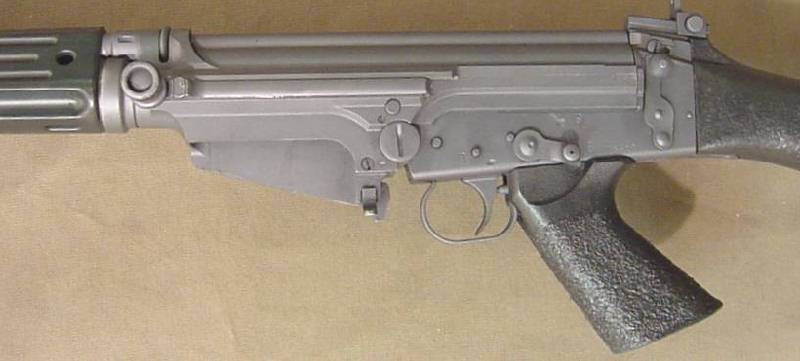
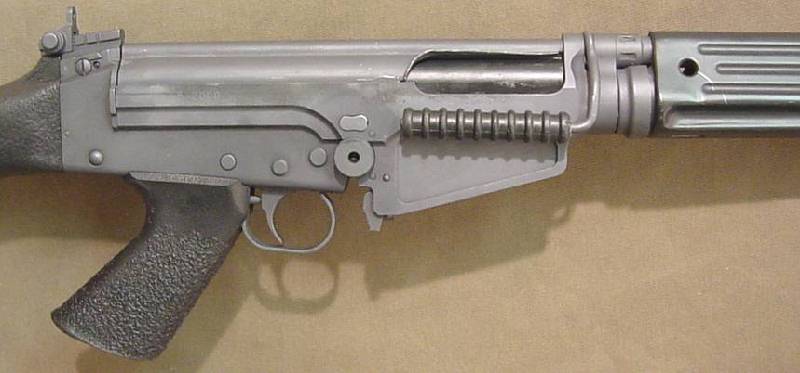
Rifle is mostly an Austrian StG-58 parts kit with some parts from other countries. Barrel has light etching in it. No major pitting, but definitely not the mirror finish and sharp lands and grooves of the typical austrian barrel from a quality shop. The bolt is South African, the butstock is Brazilian. The receiver is an interesting metric/inch hybrid. Overall finish is gray spray paint over the original well-worn Austrian phosphate finish. Handguards are painted black with a relatively durable thick paint. Bolt and carrier are also painted black with a durable baked on epoxy-type coating.

Gray spray paint wiped off with paint thinner.
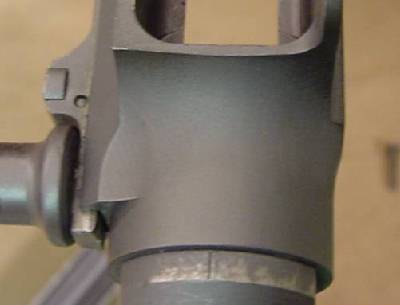
Front view of magazine well
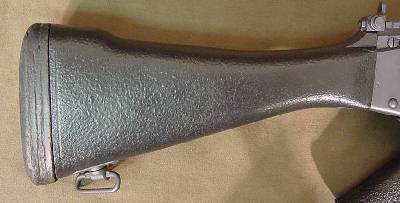
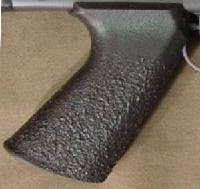
Butstock is a heavy splatter coat of a black paint over a Brazilian hump-back stock with a badly worn rubber but plate attached. Pistol grip is US made and a rubber-type material. This and the receiver are the only US parts on the rifle. Federal Import law requires rifles of this type to have no more than 10 imported parts from a list of 20 major components. The result is that 6 parts need to be replaced with US parts, or 7 if using a muzzle brake. This rifle is short four US parts, making it in possible violation of Federal Law.
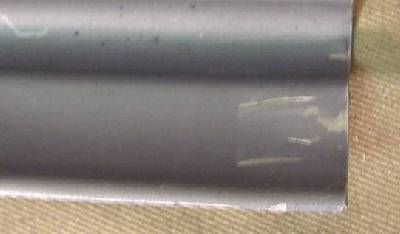
Dustcover had a large dent in it, sloppily punched out from the inside.

Black paint on handguards had incomplete coverage. It lightened after rubbing with a paper towel and paint thinner, but did not come off. The light color is not reflection, but rather bare metal.
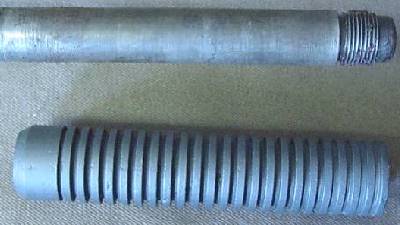
Muzzle weight is an StG-58 "Stoll" flash suppressor with the prongs cut-off. It unscrewed by hand revealing a threaded barrel and a quantity of greasy sand. Flash suppressors or barrels threaded to accept flash suppressor are forbidden by the 1994 Assault Weapons Ban. The rifle is not stamped "Gov/LE Only" or anything else to indicate this is a Law-Enforcement Only rifle and I therefore suspect it may be contraband.
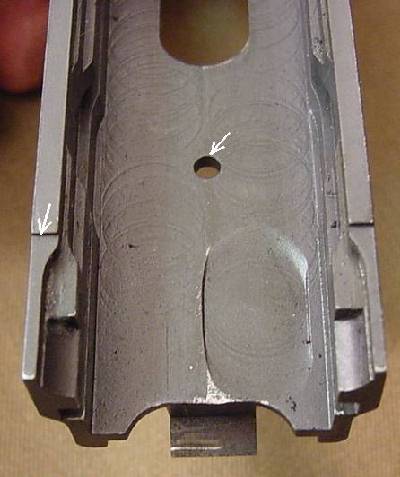
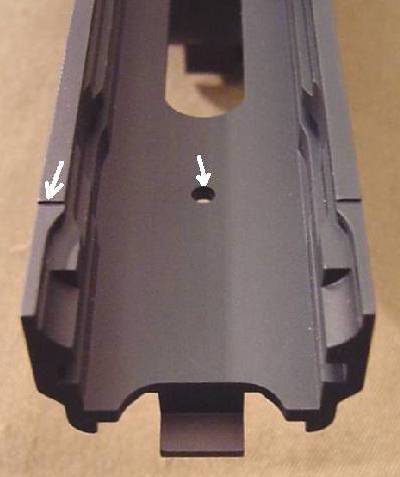
Olympic receiver (left) has sloppy machine marks. The unique and non-standard machine marks suggest this receiver was manufactured using the same programming as the current Williams Arms receiver (right). Although the current Williams Arms receiver is a drastically superior product that will be reviewed separately, it is unclear to me at this time what the relationship between Olympic Arms and Williams Arms is or was. Areas of note that are identical between and unique to the current Williams Arms aluminum receiver and the Olympic Arms receiver are the typically metric lightening cut on an inch receiver, the hole in the bottom of the receiver (possibly for indexing on a CNC mill?), the cut at the front of the pivot hole (shown below), the step at the rear, the stress relief hole at the end of the cocking handle cut (shown below), and other tool marks.
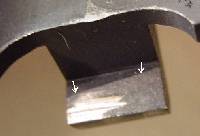

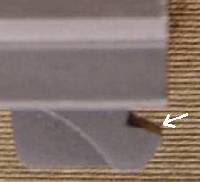
The catch on the rear of the receiver that locks to the locking body is not cut straight. This is not a shadow indicated by the arrows, but an out-of alignment cut. The correct way to fit an upper receiver to a lower is with a different sized locking body. Doing so, however, requires 5 minutes of disassembly and reassembly of the lower. Apparently, the assembler thought it more expedient to just file the receiver. A correct Imbel receiver is shown for comparison (center).
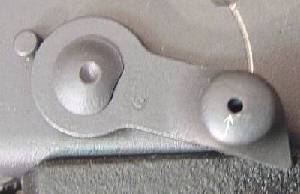
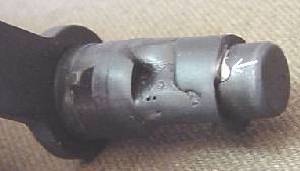
Selector lever has a hole in it and is very stiff to move. I have not seen this hole before on a metric FAL selector except on a very bad Hesse casting. This is an original Austrian part. It is possibly a variation I havn't seen before, or a Steyr defect. I don't know for certain. Selector lever is welded up to semi-auto only configuration. Since a full-auto selector lever does not make the receiver into a restricted machinegun, this modification is unnecessary, but desireable if done correctly. The weld is sloppy and the high-point indicated by the arrow is what caused the selector to bind.
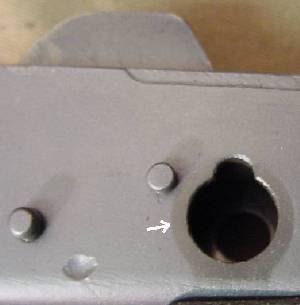
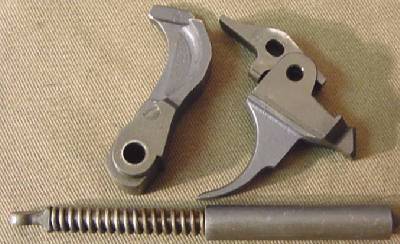
On left with selector removed shows Olympic Arms did not disassemble the rifle prior to spraypainting. The picture on right shows the paint only on the top of the hammer, the top half of the hammer strut assembly and the bottom of the trigger, again indicating it was painted as an assembled unit.
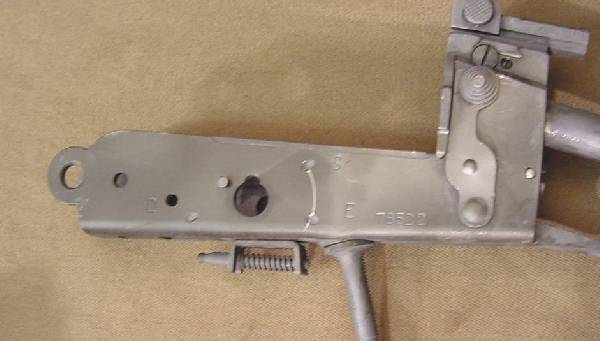
FAL lower after wiping down with turpentine which removed the gray spray paint.
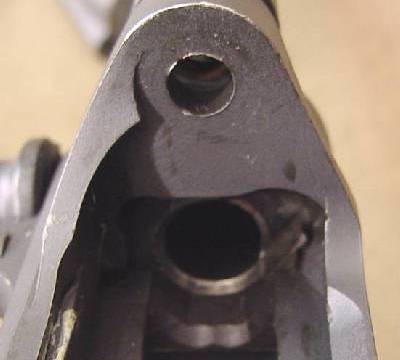

Olympic (left) without the proper relief cut around the gas piston hole and an Imbel (right) with proper cut for comparison.
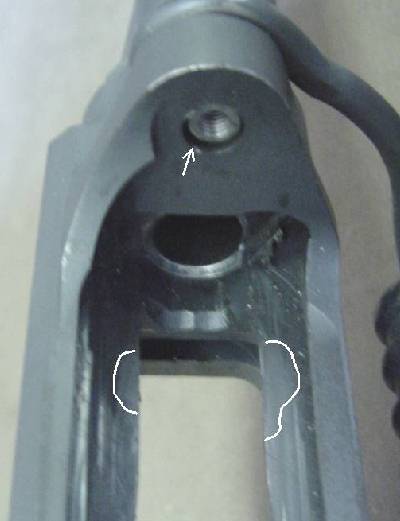
The white outline indicate an upward bulge on the internal receiver rails that causes a difficult lockup. It is not apparent to me what caused this bulging. The feedramp geometry appears correct. Note inch pattern magazine well. While a metric mag will fit in an inch mag well, there is little if any front support for the magazine and it is common to get stoppages from the rounds nose-diving and striking the bottom of the barrel face, missing the feedramp. It is my opinion that those advertising inch pattern magazine wells to work with metric magazines are not telling the whole truth. Yes they will fit. Yes they will often work. But they are not as reliable as using the correct magazine.
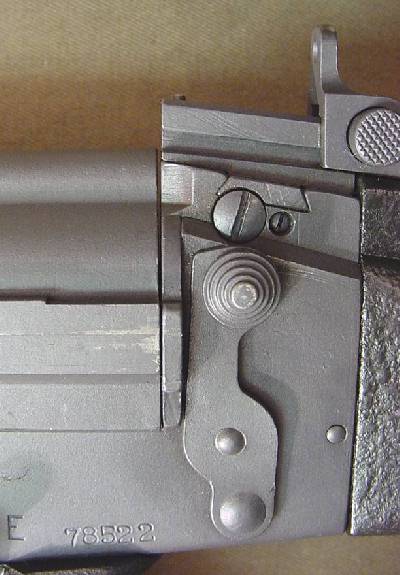
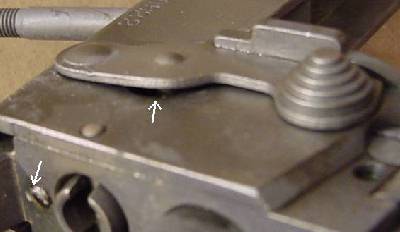
Lever, locking body is bent. Screw, retaining, lever locking body is supposed to be flush. It protrudes which prevents the stock from mating correctly with the lower receiver.
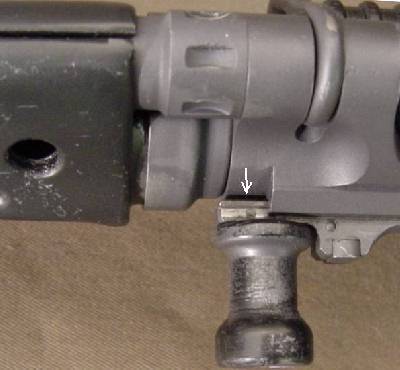
Inch cut for folding cocking handle, but with a metric imported cocking handle assembly. Note that the plunger retaining pin, normally retained by the rails in the receiver, is now exposed. A tiny shift of this part will render the cocking handle assembly inoperable. It is my opinion that metric cocking handles should never be used on inch cut receivers, although the reverse is not true.
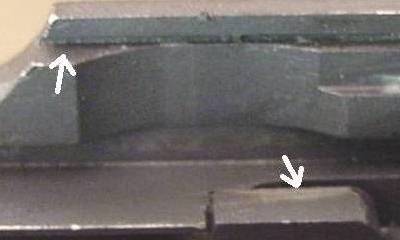
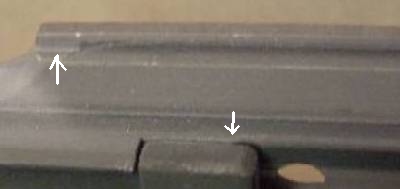
Olympic right dust-cover groove (left) improperly cut. This groove should not go all the way through. Correct Imbel (right) shown for comparison. Note also the right edge of the ejector block protruding above the rail, creating unnecesary friction.
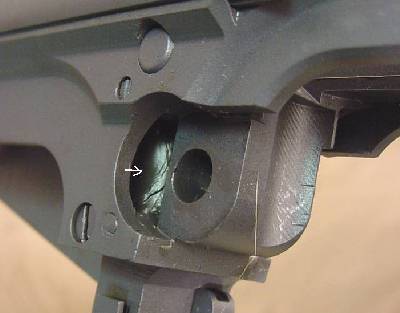
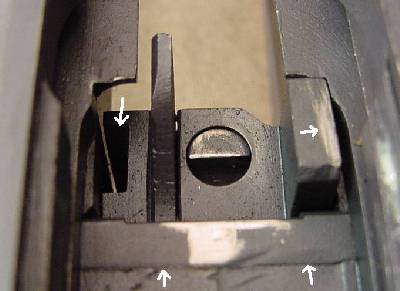
Full auto ejector block partially welded in. Having a full-auto ejector block installed in a semi auto receiver violates no laws that I am aware of. I do not understand the point of partially welding in the ejector block, instead of completely welding it in and resurfacing as DSA neatly does (almost invisible junction) to convert FA ejector blocks to SA. Notice also that the locking shoulder sticks up above the level of the receiver bottom. Also the right side of the ejector block is mounted too high causing it to interfere with the bolt carrier.
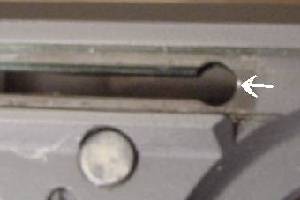
This circular cut at the end of the cocking slide groove is identical on the olympic and Williams, but not present on any other. It appears to relieve stress from this junction and is probably an improvement.
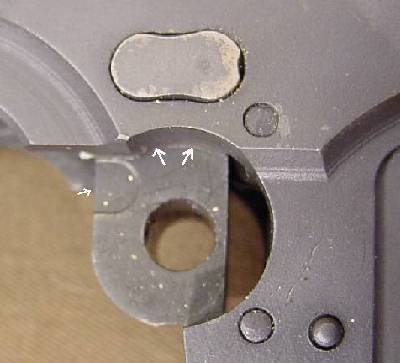
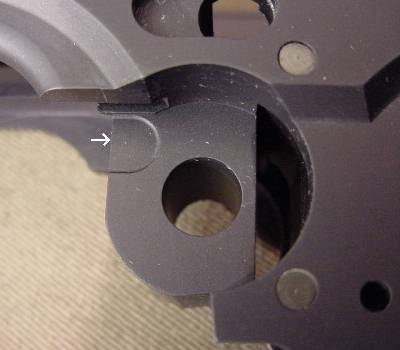
Radius cut for head of hinge pin indicated by the two arrows is too small, causing the hinge pin to bind. On this sample, somone pounded the hinge pin in anyway and this caused the shaft to distort. Hole also is not concentric and is undersize on the left side causing even a new hinge pin to bind. Note the Olympic (left) and Williams (right) both have the same round cut indicated by the arrow, which on licensed receivers is square. This is further indication of common history between these two receiver.
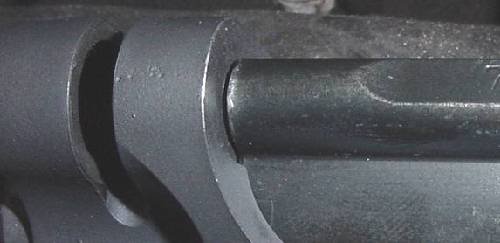
Picture shows the flared front of the bolt carrier. It is not clear what caused the battering. In this picture it is closed on a field gauge, .004" greater than a SAAMI NOGO headspace gauge. Due to the forgiving nature of the FAL, this excess headspace is not necessarily dangerous, but is borderline and in my view very sloppy.
On 11/02/01 Tom Spithaler of Olympic Arms made the following response on the Olympic Arms message board.
An opinion from one man who also freely admits to be a seller of "custom" FAL rifles himself can hardly be considered an objective one in my opinion. . . . Having just read the review by "gunplumber" of an Oly T48-2000 FAL rifle, I found I had to make an additional comment. My comment is; My first comment fell far too short in exposing shortcomings in the "investigative" review of our rifle. I found several "as fact" statments that were just outright wrong, and many other insinuations, opinions or guesses that were misleading or showed a lack of the complete grasp of the subject of which was being spoken of. I just found it rather surprising to see a self proclaimed FAL expert fall so short in some obvoius areas. " - Tom S. Oly Arms
Since Tom made some pretty serious accusations about my credibility and competence, I asked him on his forum to identify by simple cut
and paste the portions of my review that he considered inaccurate or unfair. He refused. I also asked him to reconcile the barrel threaded to accept a flash hider with the 1994 assault weapons ban making it a federal felony to manufacture or possess a rifle of this type with a barrel threaded to accept a flashider. I also asked him to reconcile the two US parts with the 1989 import ban making it a federal felony to manufacture or posess a rifle of this tkind that has more than 10 imported parts from ATF's list of 20
Tom answered neither question, then deleted my question then the entire thread on 11/05/01.
I can only assume now that Tom Spithaler of Olympic Arms is knowingly and willingly concealing the fact that the rifles his company sells (if the same as this factory example) are illegal and possession of such is a federal felony. I am understandably disappointed that Olympic Arms would willingly endanger the lives and freedom of their customers to save a few bucks on manufacture.
See Someone else's review of the Olympic T48 2000 "FAL" on the FAL Files
Oly Review Part One
Oly Review Part Two
Arizona Response Systems
5501 North 7th Avenue
Phoenix, Arizona 85013-1755
phone 623-873-1410
Home |
Finishes |
FAL |
Glock |
Gunsmith |
Notes |
Specials |
Order |
Links |
E-mail


































